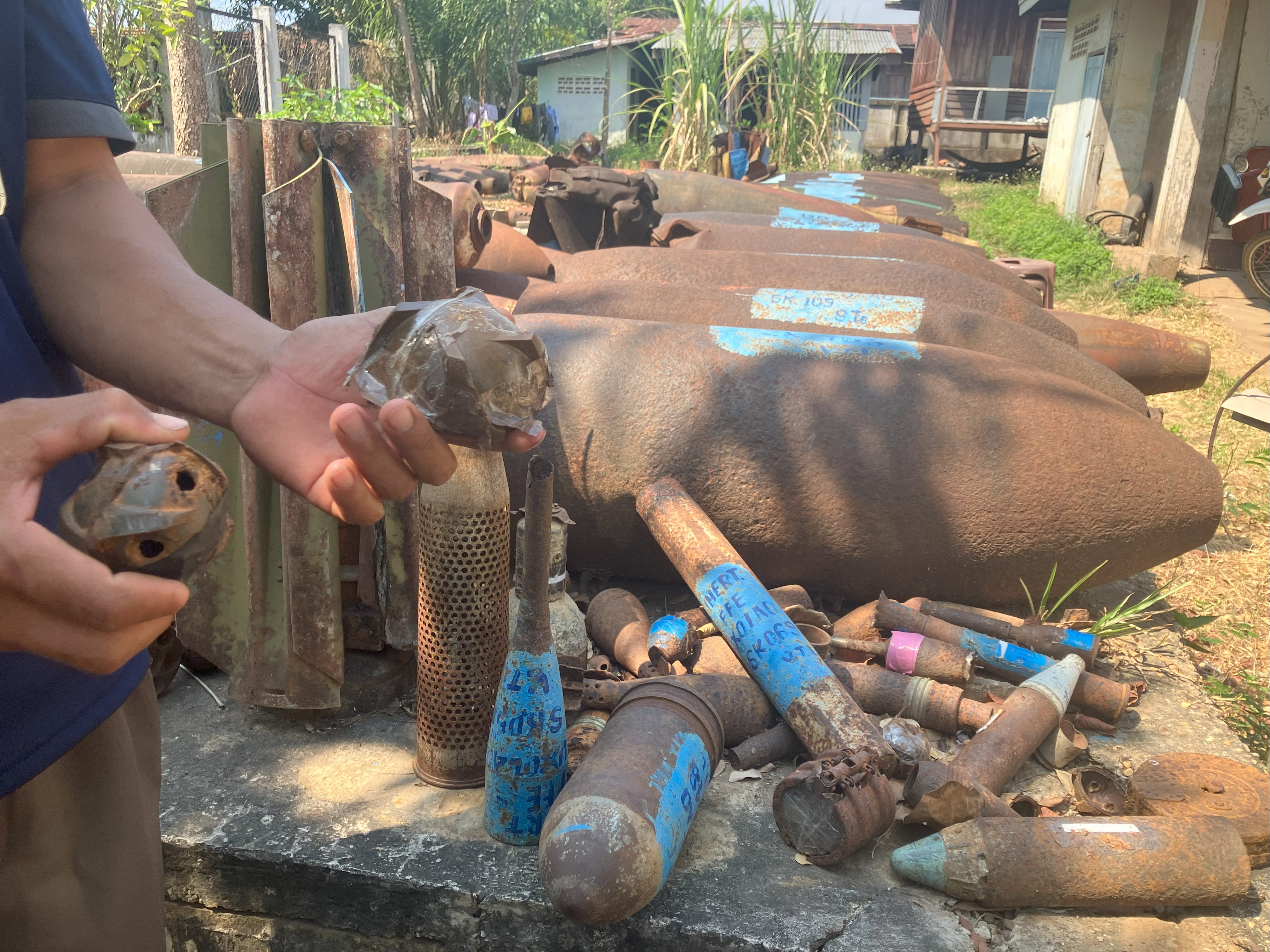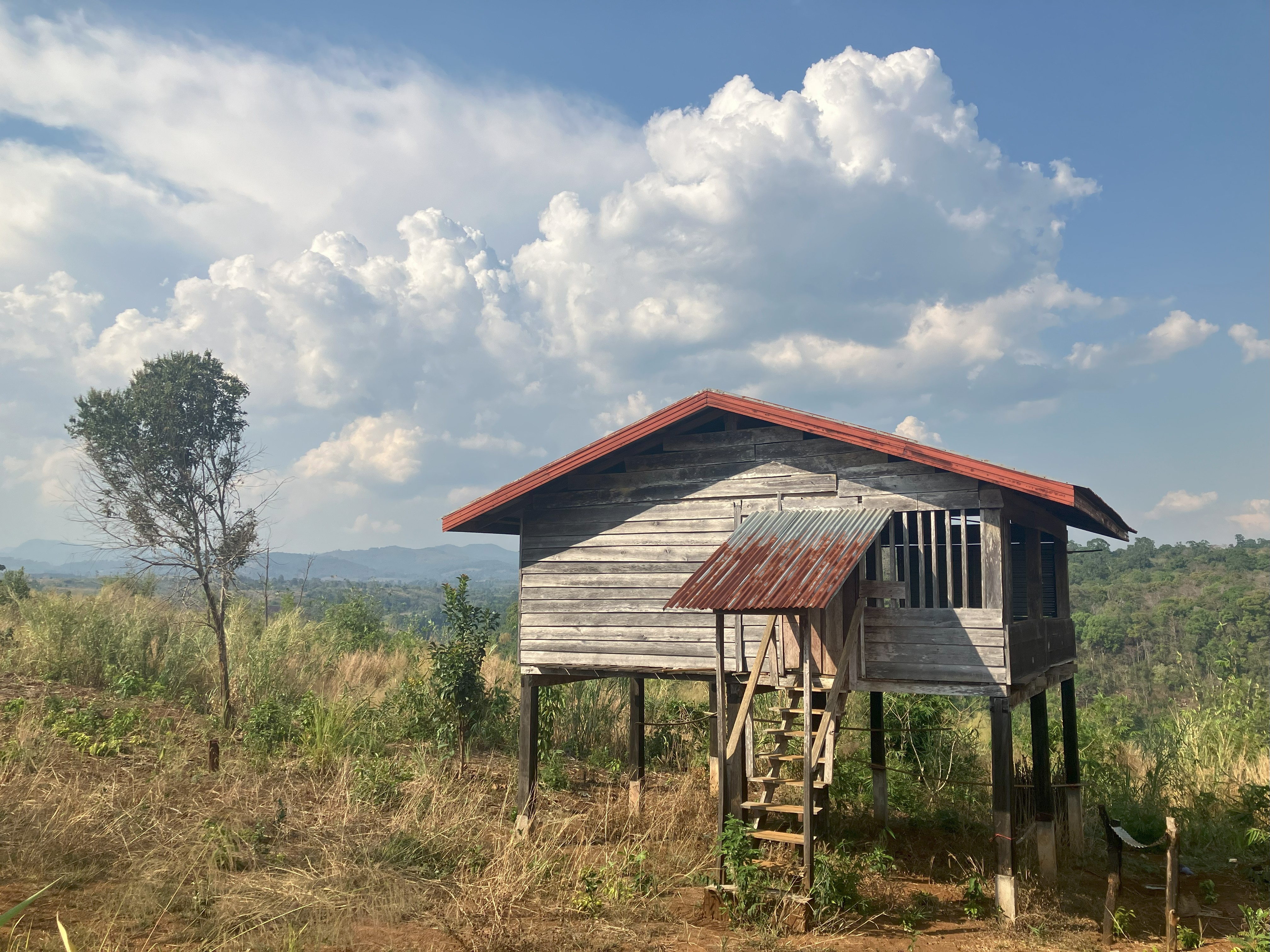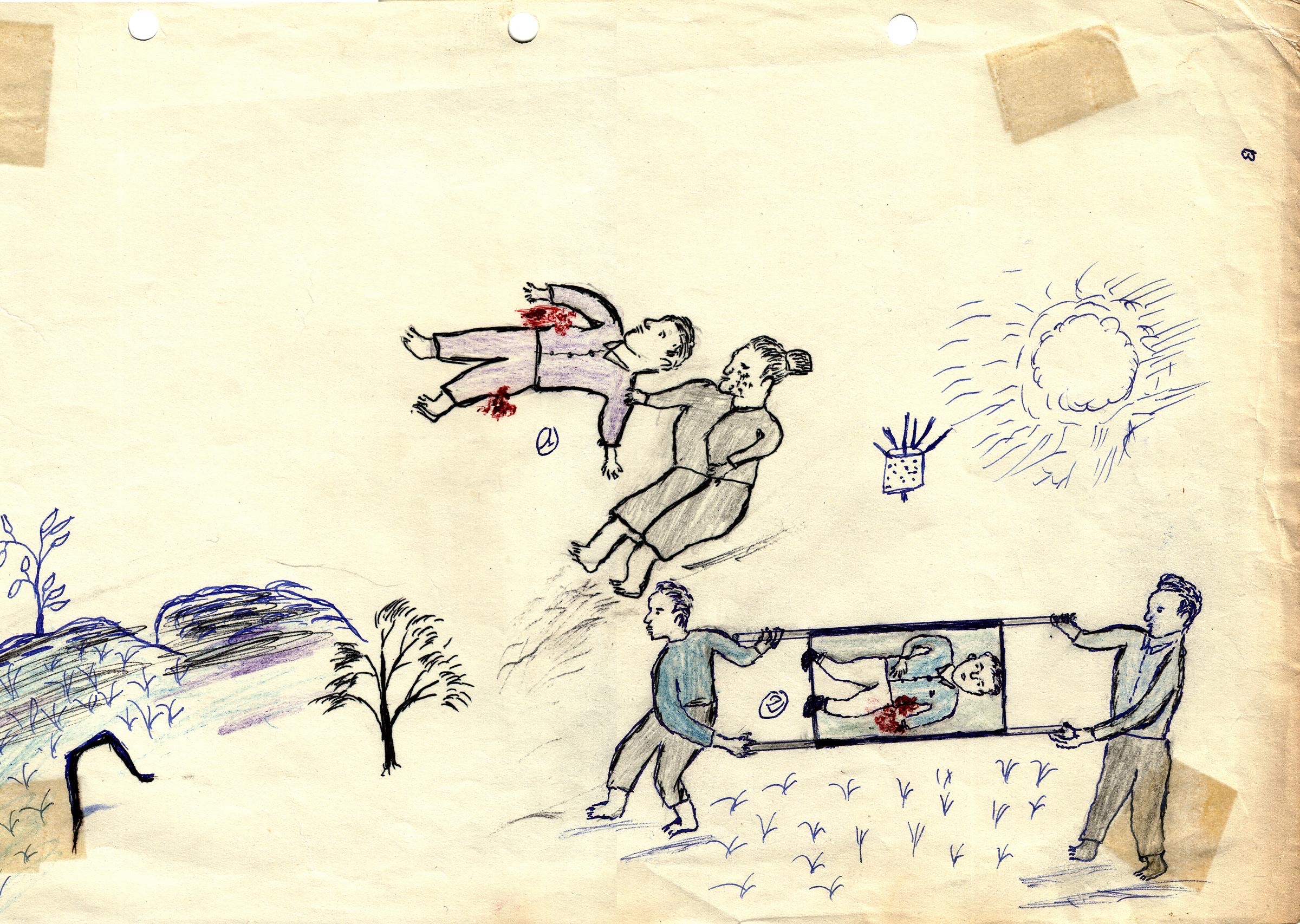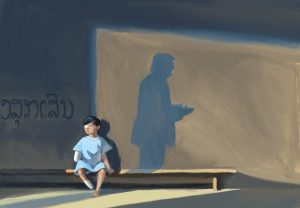I’m standing before enough heavy weaponry to level a football stadium. The bombs are arranged on a raised concrete platform behind a building site. They sit, sunbaked and rusting, in informal rows amid a scattering of mines, mortar shells, and beer bottles. Each looks menacing, from the hulking cigar-shaped canisters to the spiked cans with arms like a spider. All are disarmed, or so I’m told.
“The bombies are the worst,” says bomb recovery expert Sawan, gesturing towards a pile of metal balls. “We find them all the time.”
I pick one up to take a photo; it has the shape and weight of a baseball. These are cluster bombs: grenade-like explosives dropped in a hailstorm across a wide area.
“Maybe not that one,” says Sawan, gingerly taking the bombie and setting it aside. She hands me another wrapped in sticky tape. “This one is fine.”
I’m in southeastern Laos near the Vietnamese border. Here, Sawan and her team work to remove unexploded American bombs –the deadly remnants of a forgotten chapter of the Vietnam War.
For decades, the U.S. government supported bomb removal efforts in Laos. This reflected tacit recognition of the historic debt that Washington owed Southeast Asia for its destructive, largely futile wars in the region five decades ago.
Between 1964 and 1973, the U.S. Air Force targeted communist guerrillas and their supply lines in Laos, striking the countryside with nearly 2 million tons of explosives and chemical weapons. It’s estimated that 30 percent of these bombs, most of them cluster munitions, failed to explode. Today, Laos is home to more unexploded bombs than people.
Since the end of the war, unexploded ordnance (UXO) has killed 20,000 people in Laos, including 46 deaths last year. Around 40 percent of UXO fatalities are children.
On January 20, President Donald Trump announced a freeze on U.S. foreign aid, including UXO projects in Laos. The funds are now withheld pending a 90-day review conducted by Elon Musk’s Department of Government Efficiency.
In Laos, where American bombs continue to claim innocent lives, Trump’s actions quietly devastated a small yet much-needed aid community.
“The Lao people should be angry about that,” says Phil Robertson, the director of Asia Human Rights and Labour Advocates, a regional consultancy. “They should be angry at Donald Trump and his administration for basically blowing up the promises that were made by the United States government to the Lao government and the Lao people.”
Laos is one of Asia’s poorest countries and relies on U.S. aid to deal with UXO. In Sawan’s district, a heavily bombed region of arid hills populated by subsistence farmers, few households earn more than $17 a month. To survive, Sawan’s community must till soil, cut trees, forage, and herd livestock – activities that risk detonating UXO. Outside of her team, few people have the knowledge or resources to protect themselves.
“Everyone has a scary story,” says Sawan, whose equipment and trained staff reflect decades of U.S. support. Every year, teams like hers clear around 60,000 bombs across the country – stable progress, but minute considering the task ahead. Approximately 80 million bombs remain in Laos. Even before Trump’s cuts, Lao authorities hoped to be UXO free as late as 2125.
While Washington was its biggest donor, other countries like Japan, Norway, and New Zealand still support Sawan’s team. Thankfully, work can continue, though her capacity is much reduced.

A member of Sawan’s team holding “bombies,” or cluster bombs, the deadliest and most prevalent type of UXO, in southeastern Laos, March 2025. (Photo by Talisker Scott Hunter)
Sera Koulabdara, CEO of the UXO charity Legacies of War, believes that while other countries may increase their support in the wake of Washington’s departure, it might not be enough. “UXO clearance is a highly specialized process that requires well-trained teams, ongoing assessments, and a steady supply of resources,” she says. “The comprehensive scope and sustained funding that [the USA] brought to the table may be hard to fully replace.”
As Laos struggles to fill America’s shortfall, people continue to die. Since the aid freeze in January, Lao authorities recorded four deaths from UXO – including that of a 15-year-old girl. Koulabdara believes that America’s departure will almost certainly lead to a rise in UXO incidents.
“The repercussions of this reckless policy shift are catastrophic,” says Koulabdara, noting that 4,000 trained, U.S.-funded bomb disposal experts were forcibly stood down following Trump’s aid freeze. “More than 100 calls have flooded the clearance hotline,” she adds. “No one is permitted to respond due to the executive order.”
“This void in professional response is leaving communities dangerously exposed. It is only a matter of time before desperate villagers, left with no other option, attempt to handle the explosives themselves.”
Koulabdara joined several other UXO clearance advocates in calling on the State Department to allow U.S.-funded work to continue, requesting a waiver or a fast-tracked review process.
However, recovering bombs only addresses part of the problem. In February, Sawan’s local hospital admitted someone maimed by a UXO. Staffed by dedicated workers, Lao hospitals are often under-resourced, with limited disability services. For this blast survivor, rejoining society will be an uphill battle.
USAID initiatives like the Okard Project helped disabled UXO survivors receive wrap-around care. The ambitious, $30 million initiative trained Lao healthcare professionals, worked with hospitals to source assistive products like braces and wheelchairs, advised public health authorities on disability legislation, and helped vulnerable people earn their own incomes.
Trump gutted Okard, firing 80 percent of its staff and discarding hard-won achievements. Okard supported nearly 20,000 people in Laos, including 176 UXO survivors. Now, these beneficiaries are on their own.
“Survivors could face long-term neglect, worsening their quality of life and hindering their ability to reintegrate into society,” says Koulabdara, “The abrupt withdrawal could push many survivors into deeper poverty and social exclusion, undermining years of progress.”
“It’s tragic because people with disabilities are one of the most disenfranchised groups globally,” says Sean, a former Okard employee. “Unfortunately, most of the people we supported will not get the services they need.”

A house overlooking cassava and coffee plantations in Sekong Province, Laos, where 25 percent of the villages remain contaminated by UXO. (Photo by Talisker Scott Hunter)
USAID’s abrupt withdrawal caused Laos irreparable damage through the loss of qualified aid workers. Even if funding returns tomorrow, Okard could not deliver as before.“You cannot just start and stop [aid] projects,” says Sean. “When all our staff were laid off, they took with them years of experience.”
“They were humanitarian firefighters,” adds Robertson, incensed at how USAID firings will leave only eight full-time staff in the agency’s Asia bureau. “These people have all been sidelined and fired so there’s been a massive destruction of capacity.”
USAID’s withdrawal has undermined the entire aid sector in Laos. The U.S. was the world’s foremost provider of international aid. Now, organizations that never received American support find themselves fighting more competitors for less funding.
“I feel sad and betrayed,” says Sean. “We know the gaping hole that these programs have left, We know the faces, the stories, and pain that this loss has caused.”
“Betrayal is the stronger feeling,” he continues. “Those of us who chose humanitarian work did so because we deeply believe in the work we do.”
The Trump administration claimed that projects like Okard were wasteful. Elon Musk, who played a key role in dismantling USAID, labelled the organization “one of the biggest sources of fraud in the world.”
To Sean, Musk’s comments add insult to injury: “To see the U.S. government come after aid workers, calling them criminals and inefficient, was incredibly hard. To see one’s life work belittled and criticized in such a way, and at such a huge scale, is a great betrayal.”
Laotians like Koulabdara share Sean’s frustration. “It’s a profound betrayal,” she says.
Growing up on the outskirts of Vientiane, Koulabdara witnessed first-hand the effects of UXO. Her father, a doctor, performed emergency surgeries on blast survivors – including a schoolmate of hers.
“Eliminating USAID specialists with decades of expertise doesn’t demonstrate competence,” says Kaloubdara. “Gutting these critical programs isn’t fiscal responsibility – it’s sheer fickleness.”
As Washington shirks responsibility for the weapons it dropped on Laos five decades ago, China spies an opportunity to increase its influence by appearing the more responsible power. Vientiane is already home to several Chinese attempts to shape Laos’ development path, including the gargantuan Beijing-funded Mahosot Hospital.
“China will certainly step into the vacuum that is being created by the USAID pullback,” says Robertson. For the United States, forgone influence along a substantial length of the Mekong River represents a geopolitical setback. From a public relations point of view, lost partnerships in Laos could damage America’s already waning reputation as a reliable partner that makes good on its promises.
“Laos might be a small country, and it’s easy to push it aside and forget about it, but the U.S. has a strong interest there that needs to be recognized,” says Robertson. “there is a historical obligation by the U.S. to rectify some of the wrongs that it has inflicted on the people of Laos.”
“Albeit as imperfect as it was, there was still an expectation that the U.S. was trying to do something positive here […] now that’s completely out the window.”
What increased Chinese influence means for Lao people is uncertain. “China is not like a traditional aid donor,” continues Robertson. “It’s much more transactional. So, if you’re going to get something from China, you have to give something up.”

An illustration of the aftermath of a U.S. air raid by a Lao refugee who witnessed attacks in Xieng Khouang province, Laos, during the Vietnam War. (Image credit: Legacies of War)
“China’s aid may come with conditions that prioritize its own economic interests,” adds Koulabdara, citing the $5.9 billion China-Laos railway – paid for with Chinese loans that Laos is now struggling to pay back.
Observers like Robertson accuse Beijing of coercing Laos into economic dependence by hawking costly infrastructure projects under the guise of development aid. China’s foreign ministry refutes this claim as U.S. propaganda that undermines its legitimate partnerships with developing countries.
“China’s increasing presence in the country through aid and investment presents both opportunities and challenges,” says Koulabdara. “While it’s clear that China is stepping up its efforts, it doesn’t necessarily mean it will fully fill the gap left by the U.S.”
China’s transactional approach to aid appears to align with Trump’s foreign policy approach, which classifies humanitarian projects like Okard as dead weight because it doesn’t provide America with direct financial benefits.
To aid workers, this represents a fundamental misunderstanding of the purpose of aid work. For a fraction of the budget allocated to its military, U.S. aid projects sowed pro-American sentiment across the globe, even among Washington’s former enemies. U.S.-funded UXO clearance efforts in Laos have so far cost the American taxpayer $355 million. When it bombed Laos for nine years, the government spent that in a month.
“We haven’t done a good enough job showing the average American how [aid work] relates to their lives, improves their lives and keeps them safer,” says a former aid worker, now volunteering with the American Foreign Service Association (AFSA), the country’s foremost aid workers’ union.
“I’m on administrative leave and my staff were fired. My partners haven’t been paid and are at risk of bankruptcy. How is this a genuine review of international assistance?”
She said she feels scapegoated. “We have bipartisan support but are still an easy target to vilify because we’re spending money abroad when Americans are hurting,” she explains.
The AFSA has filed a lawsuit against the Trump administration for its allegedly unlawful dismantling of USAID. To date, scores of federal judges have ruled against the government, ordering the return of USAID funds and the reinstation of staff. USAID might yet return to Laos to help liberate its people from UXO. When, and how that happens remains uncertain.
Far from Washington, Sawan considers the situation with surprising magnanimity. “We’re struggling to find money,” she admits. “Many projects have stopped. But we’re grateful that small countries like New Zealand still support us, even for a couple of months.”
“We have to continue our work so that farmers, kids, and Lao people can be safe.”

































